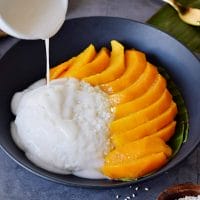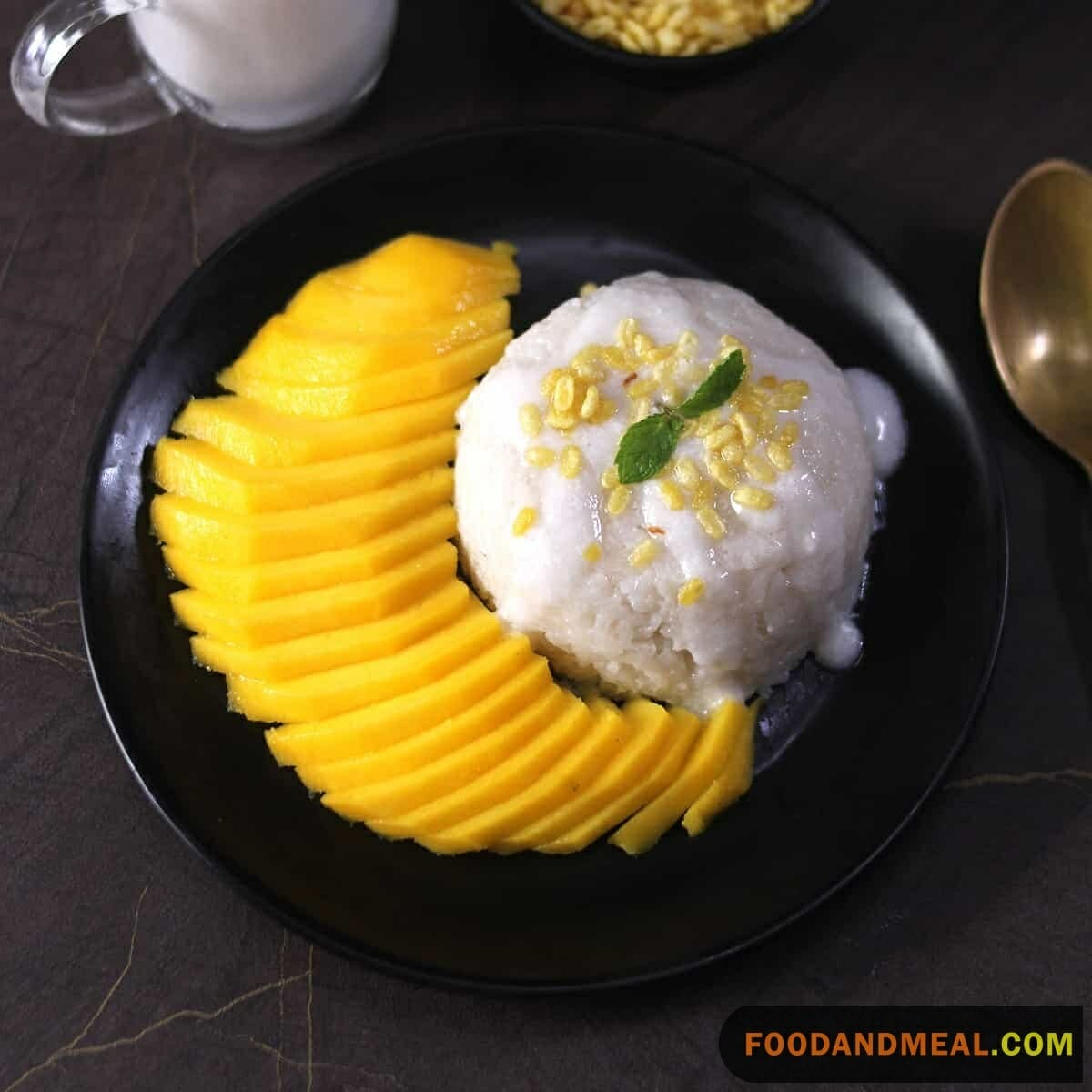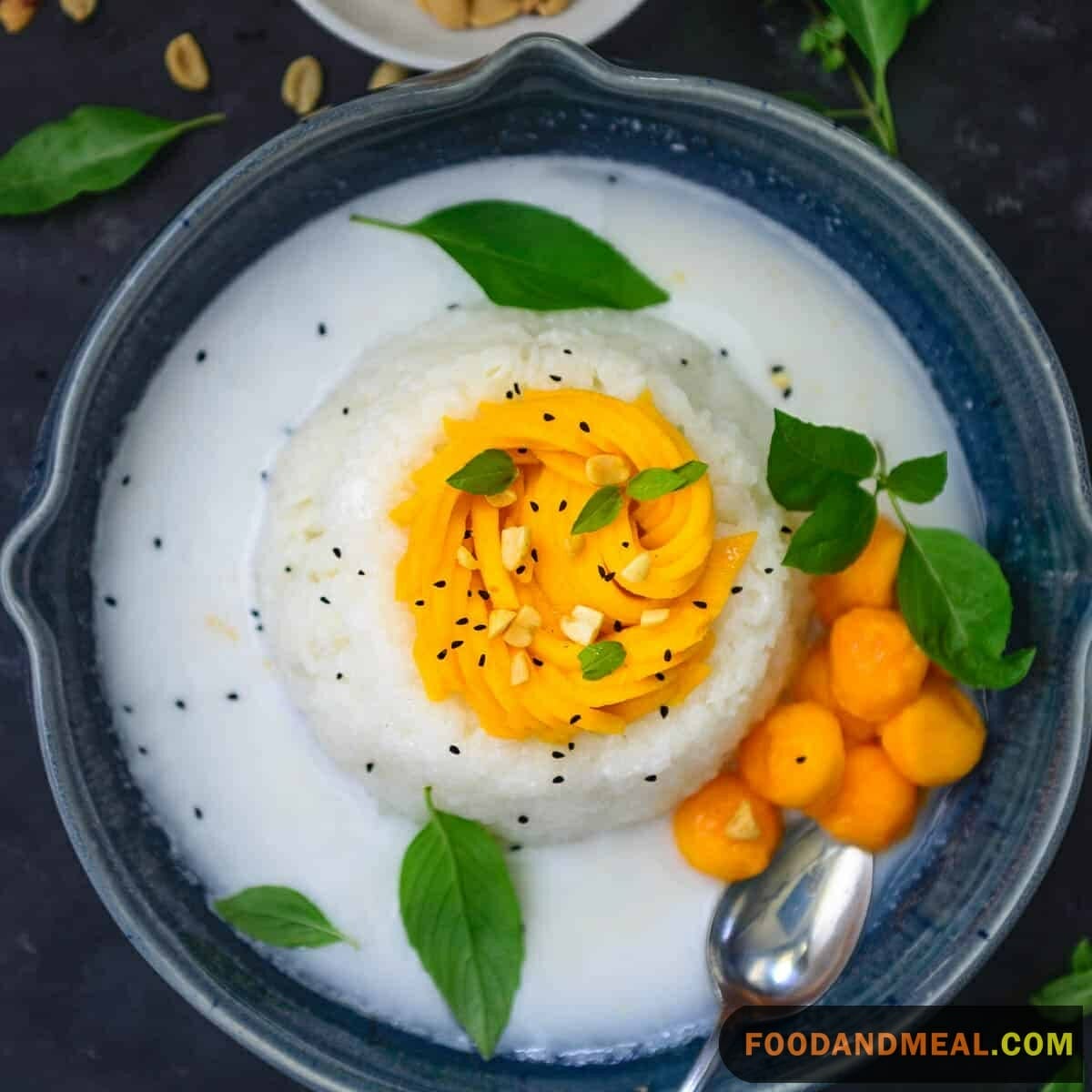Today, we’re embarking on a delectable adventure—a rendezvous with the irresistible charm of Thai cuisine. Let’s unravel the secrets of Thai Mango Sticky Rice, a dessert that’s not just about taste but about evoking emotions, memories, and the joy of creating something remarkable.

Thai Mango Sticky Rice Recipe

Thai Mango Sticky Rice Recipe
Ingredients
- 1 1/2 cup Water
- 2 Ripe mangoes
- 1 cup Thai sweet rice
- 1 can Coconut milk
- 3/4 teaspoon Salt
- 5 tablespoon Brown sugar
Instructions
- Add half cup of water, rice, plus half can of the coconut milk, the salt, and one tablespoon of the brown sugar.
- Stir well.
- Add coconut milk, salt, and some of the brown sugar to the saucepan.
- Bring to a gentle boil, and then partially cover with a lid.
- Reduce heat to medium-low, or just until you get a gentle simmer.
- Simmer thirty minutes, or until the coconut water has been absorbed by the rice.
- Turn off the heat but leave the pot on the burner with the lid on it tightly.
- Allow it to stay for five minutes.
- To make the sauce, warm the remaining coconut milk over medium-low heat.
- Add three tablespoons of brown sugar, stirring to dissolve.
- Prepare the mangoes by cutting them open and slicing each into bite-sized pieces.
- Scoop some warm rice into each serving bowl, and then drizzle lots of the sweet coconut sauce over the top.
- Arrange mango slices on the rice and finish with a drizzle of more sauce.
- Your dish is ready to be served.
Video
Notes
- Selecting the Right Rice: Opt for glutinous rice (also known as sticky rice) for the best results. This type of rice has a unique texture that's essential for achieving the signature stickiness of the dish.
- Soaking Time: Soak the glutinous rice for at least 6 hours or overnight. This step softens the grains and allows them to absorb water evenly during steaming.
- Steaming Method: Use a bamboo or metal steamer lined with cheesecloth for the steaming process. This ensures proper airflow and prevents the rice from sticking to the surface.
- Coconut Milk Infusion: When preparing the coconut sauce, ensure the heat is kept on low while simmering. This prevents the coconut milk from curdling and helps achieve a smooth and velvety consistency.
Nutrition
© Food And Meal
This website provides approximate nutrition information for convenience and as a courtesy only. Nutrition data is gathered primarily from the Spoonacular Database, whenever available, or otherwise other online calculators.
Cooking Tips

- Mindful Soaking: Soak the glutinous rice for the recommended time—6 hours or overnight. This step ensures even cooking and a tender texture that’s essential for authentic sticky rice.
- Proper Steaming: Steam the soaked rice with precision. Use a bamboo or metal steamer lined with cheesecloth to prevent sticking and achieve uniform heat distribution.
- Gentle Stirring: When combining the cooked rice with the coconut sauce, stir gently to coat the rice evenly. This step ensures each grain is infused with the creamy goodness.
- Creamy Coconut Sauce: Simmer the coconut milk gently on low heat while making the sauce. Stir occasionally to prevent curdling and achieve a silky, consistent texture.
- Sugar and Salt Balance: Finding the perfect balance between sweetness and a pinch of salt is key. Start with modest amounts and adjust according to your taste preferences.
- Mango Selection: Choose ripe mangoes with a captivating aroma and vibrant color. Their natural sweetness will enhance the dish’s flavor and visual appeal.
- Cooling Gracefully: After mixing the rice and coconut sauce, allow the mixture to cool slightly before serving. This preserves the intended consistency of the dish.
Serving suggestions

- Mango Rose Delight: Transform your dish into a work of art by shaping mango slices into delicate rose-like arrangements atop the sticky rice. It’s a visual feast that mirrors the dish’s elegance.
- Coconut Cream Drizzle: Elevate the creaminess by drizzling a touch of extra coconut milk over the dish just before serving. The rich flavor adds an indulgent layer of delight.
- Sesame Crunch: Enhance the texture by sprinkling toasted sesame seeds over the mango sticky rice. The nutty crunch offers a delightful contrast to the smoothness of the rice and mango.
- Edible Flowers: Garnish with edible flowers like jasmine or orchids to introduce a touch of floral elegance. The vibrant colors and delicate aromas add a whimsical touch.
- Tropical Fruit Medley: Create a vibrant medley by adding other tropical fruits like pineapple, papaya, and kiwi to the plate. Their freshness complements the sweet mango beautifully.
- Coconut Ice Cream Duo: Pair your Thai Mango Sticky Rice with a scoop of coconut ice cream for an indulgent dessert experience that harmonizes with the coconut-infused rice.
FAQs of Thai Mango Sticky Rice

- What is Thai Mango Sticky Rice? Thai Mango Sticky Rice, known as “Khao Niew Mamuang” in Thai, is a classic Thai dessert that combines glutinous rice, ripe mangoes, and a creamy coconut sauce. It’s a harmonious blend of sweet, creamy, and chewy textures.
- Can I use any type of rice for this dish? For the authentic sticky texture, it’s recommended to use glutinous rice, also known as sticky rice. Regular rice won’t yield the desired consistency.
- How do I know when the rice is properly soaked? After soaking for 6 hours or overnight, the rice grains should be plump and slightly translucent. They should break easily when pressed between your fingers.
- Can I steam the rice without a bamboo steamer? Yes, you can use a metal steamer lined with cheesecloth as an alternative to a bamboo steamer. The goal is to ensure even and thorough steaming.
- What type of mangoes are best for this dessert? Ripe, fragrant mangoes such as Alphonso, Ataulfo, or Champagne mangoes are excellent choices. They are sweet and complement the dish perfectly.
Hi! I'm Nazia of ‘Nazia Cooks’, a self-taught baker and cook residing in Chennai. Rooted in the rich South Indian culinary landscape, my palate has expanded to embrace global flavors. I revel in crafting fusion dishes, melding traditions to birth unique tastes.



